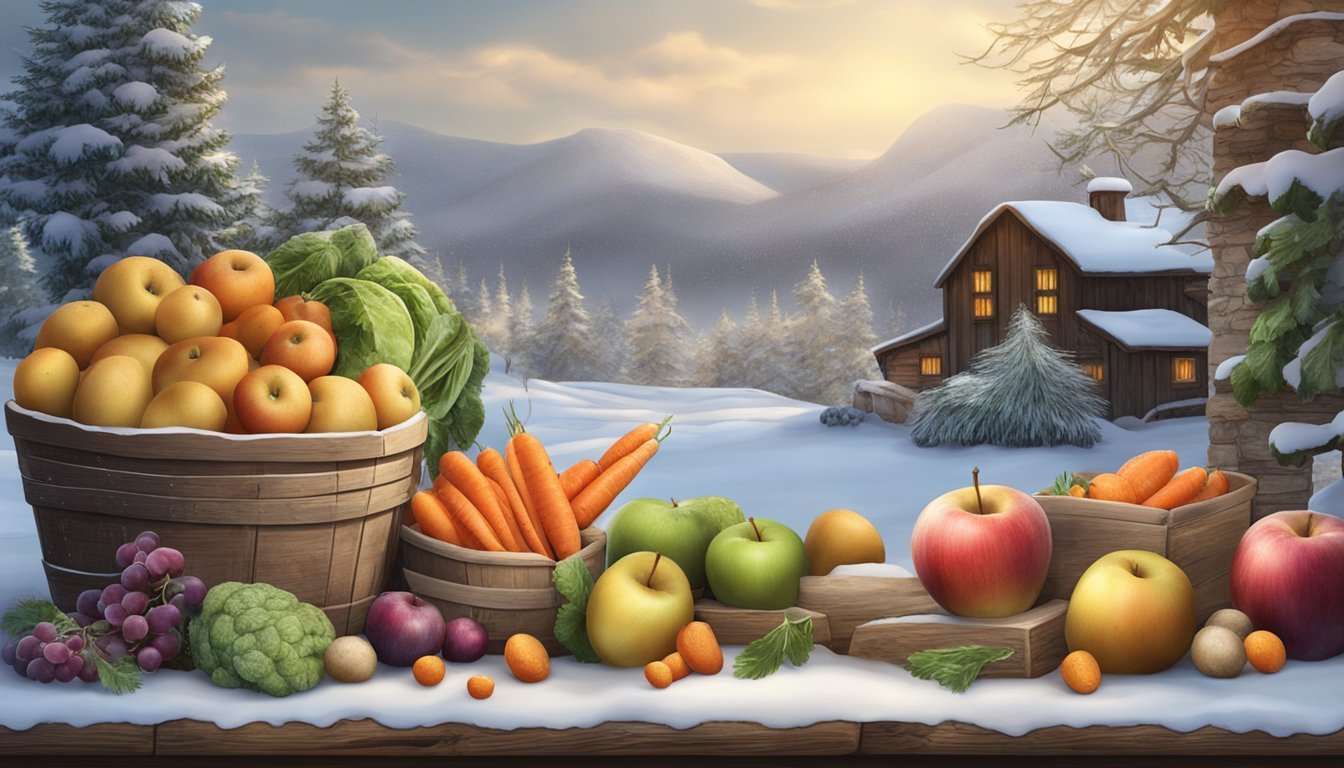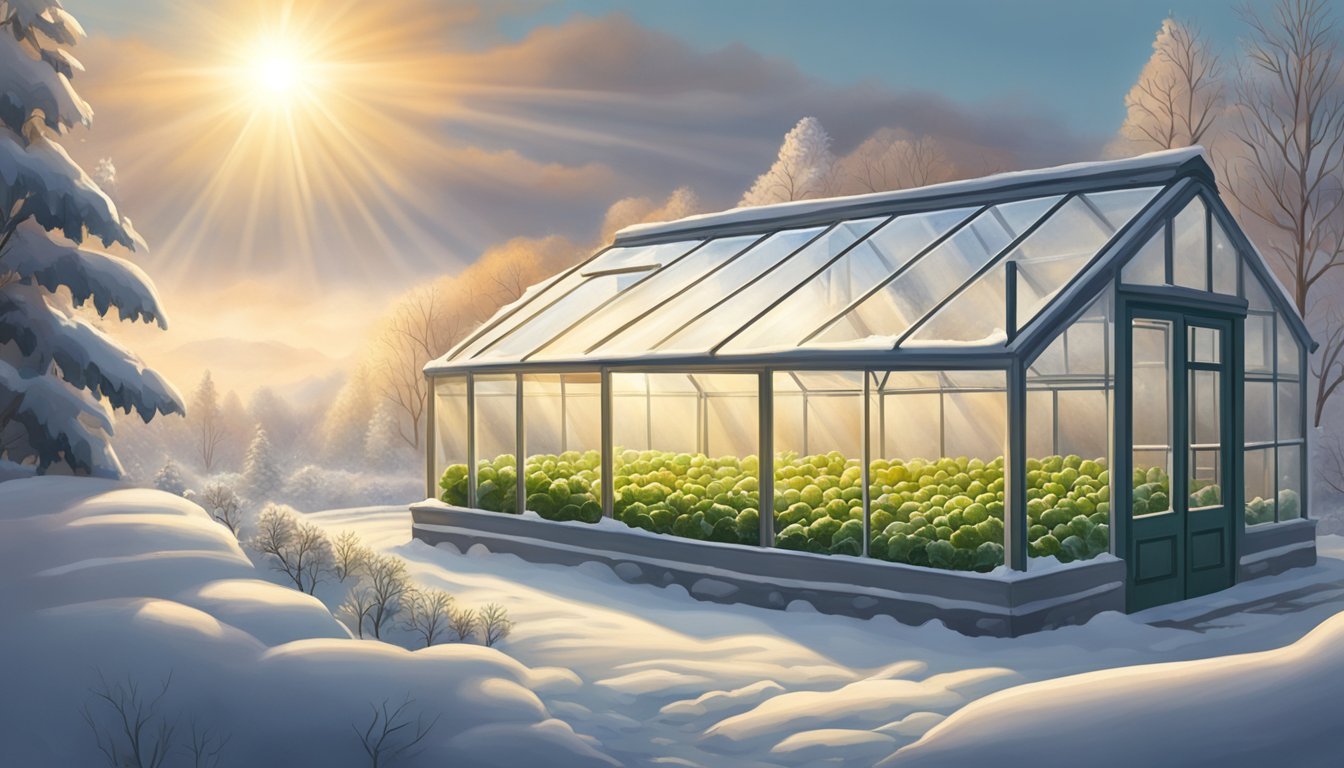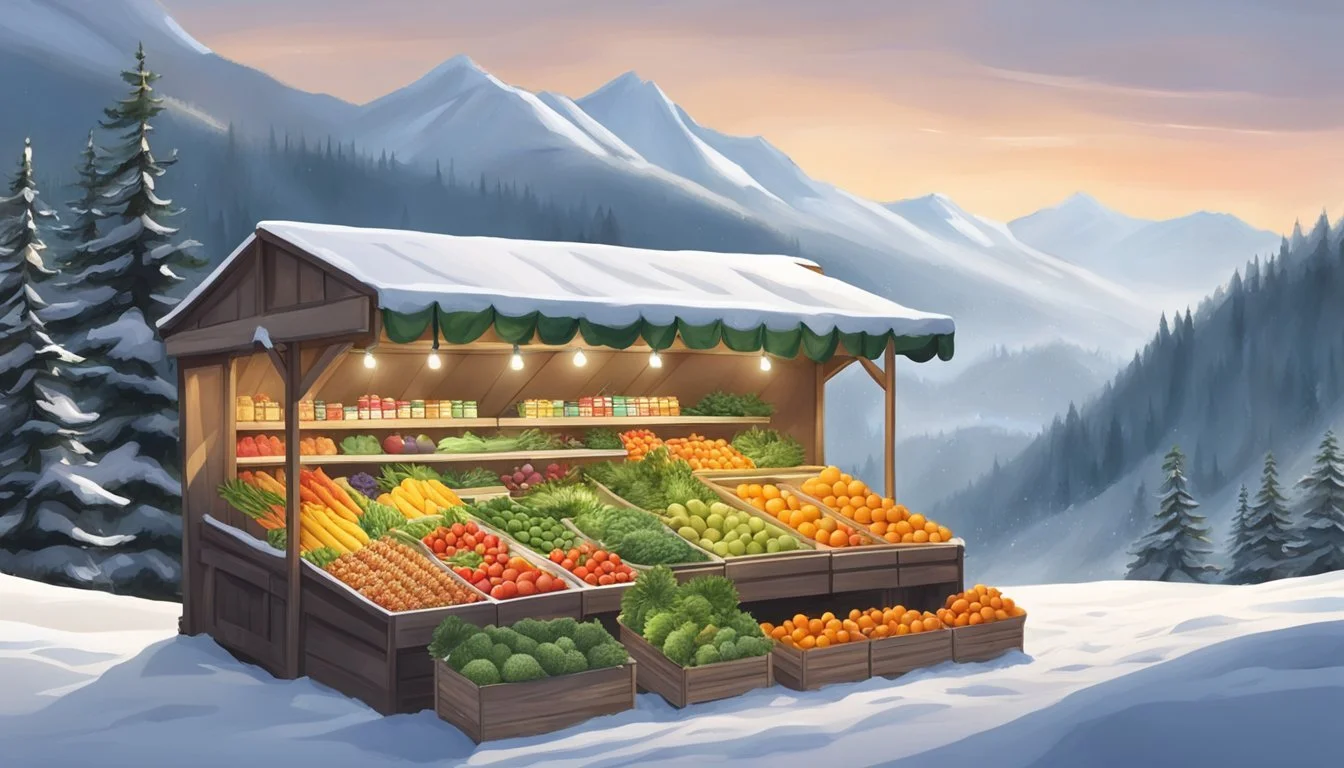Alaska Seasonal Fruit & Vegetables in February
Winter Harvest Guide
This Article is Part of our Alaska Seasonal Fruit & Veg Calendar
In Alaska, February is a time when the winter persists, but it doesn't diminish the availability of seasonal produce. This month offers a selection of fruits and vegetables that are either stored from previous harvests or grown in environments protected from the harsh climate. Root vegetables like rutabagas are often available from cold storage, providing a fresh and nutritious option for winter meals.
Citrus fruits, while not native to the Alaskan climate, are at their peak in many growing regions during February, making them widely available and particularly flavorful. Alaskans take advantage of this season to incorporate ingredients such as lemons, limes, and oranges into their diets. These fruits are valued not just for their taste but also for their vitamin C content, which is essential during the colder months.
Storage and controlled environment cultivation play significant roles in supplying fresh produce during the Alaskan winter. Greenhouses make it possible for some fresher vegetables like spinach to be harvested, despite the deep snow outside. Thus, the residents adapt and continue to enjoy a variety of produce in their winter cuisine, reflecting a blend of resourcefulness and appreciation for seasonal eating.
Understanding Alaska's Unique Growing Conditions
Alaska's growing season presents specific challenges and benefits due to its climate. The cold temperatures and variations in daylight play a significant role in agricultural activities.
Challenges of Winter Harvesting
Winter in Alaska poses considerable challenges due to the harsh climate and extended periods of darkness. Sub-zero temperatures and heavy snowfalls can cause logistical issues and transport delays. The soil remains frozen, and outdoor cultivation is nearly impossible without the aid of heated greenhouses. Specific strategies such as utilizing high tunnels or row covers may extend the growing season slightly but requires significant effort and investment.
Benefits of Seasonal Produce
Despite the difficulties, Alaska's seasonal produce thrives during the appropriate months, offering a burst of freshness and quality rarely matched. During the short spring and summer, the extended daylight hours result in rapid plant growth. This can lead to some vegetables and fruits having a concentrated flavor profile due to the intense and prolonged sunlight. The unique environmental stress can also cause plants to accumulate high levels of nutrients and antioxidants.
Seasonal Benefits Description Enhanced Flavor Concentrated due to long daylight hours. Nutrient-Rich Produce Higher nutrient levels because of environmental stress.
Local food also supports Alaska's economy and minimizes the carbon footprint linked to importing goods. This creates a sense of community around Alaskan-grown food, fostering a sustainable, local food culture even in the most challenging of climates.
February's Seasonal Overview
In February, Alaska's produce selection is limited due to the harsh winter conditions. However, the state still offers a range of hardy vegetables and the tail end of some stored harvests from previous months.
Characteristics of Winter Produce
During winter, particularly in February, produce in Alaska tends to consist of root vegetables and other hearty crops that are capable of withstanding cold temperatures. While the selection is less varied compared to the warmer months, consumers can still enjoy the quality and richness of what is seasonally available.
Root Vegetables: These vegetables are typically at their sweetest in the winter, as the cold stimulates sugar accumulation.
Rutabagas
Carrots
Cold Storage Crops: Some produce harvested in the fall can be stored and used throughout the winter months.
Potatoes
Cabbage
Comparison With Other Seasons
Summer and Fall: These seasons offer an abundance of fruits and vegetables in Alaska, such as berries and leafy greens, which are absent in the winter.
Summer: Berries like salmonberries and strawberries thrive.
Fall: Harvests include a wider array of vegetables like kale (What wine goes well with kale?) and cauliflower (how long does cauliflower last?).
In contrast, February's produce is more limited but still provides essential nutrients and flavors that can be celebrated in winter dishes. With the focus primarily on storage crops and winter-harvested vegetables, the options available are robust, featuring a concentrated sweetness and earthiness that is unique to the season's harvest.
Winter Vegetables in Alaska
Despite the harsh winters, Alaska still offers a range of vegetables that endure the cold season. Many root vegetables and some leafy greens are available, often stored from late summer harvests.
Root Vegetables Inventory
Alaskans rely on a robust stockpile of root vegetables that store well in cold conditions. Key staples include:
Carrots: These are hearty and can be stored in cool conditions, providing sweetness and crunch to winter dishes.
Potatoes: A versatile staple that can last throughout the winter when properly stored.
Turnips: These are often available from late summer into winter, adding earthy flavors to meals.
Parsnip: Sweeter and starchier cousin to the carrot, this root vegetable is a common find in Alaska's winter pantries.
Onions: Essential for flavoring, onions are a durable storage vegetable.
Vegetable Storage Taste Profile Carrots Cool, dry conditions Sweet, crispy Potatoes Dark, well-ventilated space Earthy, versatile Turnips Cool, humid conditions Bitter, earthy Parsnip Cold, moist conditions Sweet, nutty Onions Cool, dry areas Pungent, sharp
Leafy Greens and Cruciferous Vegetables
While many leafy greens are a challenge to grow during the Alaskan winter, some hardy varieties are available:
Kale: Known for its cold resistance, kale can be harvested into the winter months.
Cabbage: Often stored after late summer harvests to last through winter, cabbage is a hardy option.
Spinach: A cold-tolerant green, sometimes grown in greenhouses for winter availability.
Brussels Sprouts (how long do brussels sprouts last?): They can withstand frost, making them suitable for colder climates.
Cauliflower and Broccoli: While more challenging due to freezing temperatures, these vegetables can also be found as stored goods from earlier harvests.
Greens are typically grown in late summer and stored or grown in controlled environments during winter.
Leafy Green/Cruciferous Vegetable Storage/Growth Characteristics Kale Greenhouses, cold frames Hardy, nutrient-rich Cabbage Cool, humid storage Dense, long-lasting Spinach Greenhouses Tender, versatile Brussels Sprouts Outdoor, tolerates frost Compact, savory Cauliflower Store after harvest Mild, versatile Broccoli Store after harvest Earthy, fibrous
These vegetables represent the resilience of Alaskan produce, providing nutrition and taste despite the challenging growing environment.
Fruits Available in February
In Alaska during February, fresh locally-grown fruits are scarce due to the harsh winter conditions. However, consumers still have access to a variety of fruits through cold storage and imports, with citrus and exotic fruits being more prevalent.
Citrus and Exotic Fruits
Citrus fruits, due to their peak season in warmer climates during winter, are widely available in Alaska in February. Shoppers can expect to find a vibrant selection of:
Lemons: Bright, tangy, and versatile for both culinary and household uses.
Blood Oranges: Distinctive for their deep red flesh and sweet-tart flavor.
Oranges: A popular choice, they are sweet and juicy, perfect for snacking or juicing.
These fruits are typically imported from areas with milder winter climates where they are in season.
Cold Storage and Imported Fruits
Beyond citrus, Alaskans rely on fruits that have been stored from previous seasons or imported. Apples and pears are two such fruits that maintain quality through cold storage and are common in February markets. Varieties often include:
Apples: Offering a range from sweet to tart, apples remain crisp and are suitable for eating raw or cooking.
Pears: With a buttery texture, they are versatile for both sweet and savory dishes.
While these fruits are not locally grown during the winter, cold storage technology and global importation make them readily available to Alaskan consumers.
Cooking and Preparing Seasonal Produce
In the heart of winter, Alaska offers a unique variety of produce that inspires a range of culinary preparations. From hearty winter vegetables to the last preserves of autumn’s bounty, each ingredient can be transformed into nourishing and flavor-packed dishes.
Winter Recipes and Cooking Tips
Hearty vegetables such as cabbage, kale, potatoes, and cauliflower are staples in Alaskan winter meals. One can prepare kale recipes that include sautéed kale as a side dish, or kale can be incorporated into soups and salads for added nutrients. When it comes to potato recipes, they offer versatility; from baked potatoes to mashed potatoes or soups, there's always a method to bring warmth to the table.
Cabbage and cauliflower are excellent when roasted to bring out their natural sweetness, or can be used in stews for comfort during the colder months. Due to the lack of fresh fruits, Alaskans often rely on preserved berries and fruits for making desserts and smoothies.
Soups: Root vegetables create a robust base for soups that are both filling and warming.
Salads: For a crisp side, raw shredded vegetables like cabbage offer texture and freshness.
Side Dishes: Roasting vegetables with herbs and spices provides a comforting accompaniment to any meal.
Desserts: Preserved fruits add a sweet touch to desserts, bringing a taste of summer past.
Preservation Techniques for Off-Season
To enjoy the flavor of seasonal produce throughout the year, Alaskans employ various preservation techniques. These methods include canning, freezing, pickling, and fermenting, each preserving the taste and nutritional value of the produce for later use.
Canning: Suitable for fruits and berries to make jams and preserves for desserts or as condiments.
Freezing: Works well for berries, which can be used later in smoothies or baked goods.
Pickling: Ideal for vegetables like cabbage and cauliflower, enhancing their flavor for use in salads and as side dishes.
Fermenting: Common for cabbage to make sauerkraut (how long does sauerkraut last?), a traditional and healthy addition to various recipes.
By applying these techniques, seasonal produce can be enjoyed in numerous preparations, ensuring that Alaskan cuisine remains rich and varied even during the colder months.
Where to Find Seasonal Produce
When seeking seasonal produce in Alaska during February, one's best bets include local farmers markets and major grocery stores. These outlets offer a range of fresh, locally-sourced fruits and vegetables.
Local Farmers Markets
Farmers markets are ideal for finding fresh, Alaskan seasonal produce directly from the source. Buyers can expect food items that have traveled shorter distances and are often harvested closer to their purchase date. The interaction with local growers allows for insight into the origins of the produce and supports the local economy. Here's where you might find farmers markets and what they offer:
Anchorage Market and Festival: Featuring a variety of seasonal items including root vegetables and hearty greens.
South Anchorage Farmers Market: Known for late-winter root vegetables and greenhouse-grown produce.
To locate additional farmers markets across Alaska and their operation schedules, visiting the Alaska Department of Natural Resources Division of Agriculture website can provide the most current information.
Supermarkets and Grocery Stores
Grocery stores also provide a wide selection of seasonal fruits and vegetables. Most supermarkets have sections dedicated to organic or locally-sourced produce, which could include items such as:
Root Vegetables: Potatoes, beets, and carrots that have been stored from the fall harvest.
Cruciferous Vegetables: Cabbages and brussels sprouts are often available, having been stored or shipped from nearby regions where they grow during winter.
Consumers should look for signage that indicates "Local" to find Alaskan-specific produce. Grocery stores with robust selections include Fred Meyer, Safeway, and local co-ops like Co-op Market Grocery & Deli in Fairbanks, where one can often find seasonal and local produce.
Leveraging Produce Throughout the Year
In Alaska, understanding and incorporating seasonal produce into one’s diet can be both rewarding and challenging, given the state’s unique seasons. Individuals and businesses alike benefit from planning according to the availability of fresh fruits and vegetables throughout the year.
Seasonal Eating Patterns
Consumers should note that Alaska's winter produce availability can be limited due to the harsh weather conditions. Winter produce often includes storage-friendly choices such as potatoes and carrots. Despite this, consumers can still enjoy a range of fruits in February, with imported options like apples, clementines, and grapefruits supplementing local offerings. As one transitions from winter to spring, they can anticipate the arrival of fresh greens and herbs as the growing season begins, followed by a greater variety of fruits and vegetables in summer and fall.
List of Common Winter Produce in Alaska:
Apples
Carrots
Potatoes
Cabbage
Planning Ahead for Varied Seasons
For Alaskan growers and buyers, planning is essential to maximize the yield and availability of produce. One strategy involves preserving summer and fall harvests through canning, freezing, and cellaring to extend their use into the colder months. This ensures a supply of fruits like berries and vegetables such as zucchini long after their peak season ends.
Canning: Berries, cucumbers (as pickles)
Freezing: Peas, berries, zucchini
Cellaring: Potatoes, beets, carrots
Moreover, individuals can consult local Alaskan produce calendars to better anticipate seasonal changes and prepare accordingly. This enables them to support local agriculture by purchasing at peak ripeness and encourages a more sustainable lifestyle through reduced reliance on imported goods.
Community and Economic Impact
In Alaska, the focus on seasonal fruit and vegetable consumption is not just a culinary preference but also a driving force for local economics and community strengthening. Through supporting local agriculture and taking advantage of the economic benefits of seasonal shopping, communities across the state stand to gain.
Supporting Local Agriculture
Local Agriculture is a cornerstone of community life in Alaska. When residents choose to purchase seasonal produce, they're investing in the state's agricultural sector, which comprises various crops despite the challenging climate. Local farmers' markets provide venues where consumers can buy directly from growers, ensuring that money spent on food stays within the community. This direct form of economy bolsters Alaska's agricultural resilience and sustains farming operations that could otherwise struggle to compete with imported goods.
Key Produce: Even in winter, certain hearty vegetables thrive and are available.
Consumer Preferences: There's a growing trend for locally-sourced menus, reflecting a dedication to community-grown goods.
Economic Benefits of Seasonal Shopping
Seasonal shopping for fruits and vegetables in Alaska has clear Economic Advantages. When consumers buy what's in season, they often enjoy lower prices due to reduced transportation and storage costs. Additionally, it encourages a demand for local goods, which in turn can stimulate job creation within the state's agricultural and retail sectors.
Financial Circulation: Money spent on local produce is more likely to be reinvested in the state's economy, amplifying its impact.
Economic Reports: Studies, such as those by the McDowell Group, have highlighted the potential of locally-grown produce to significantly affect the state's economy, with millions spent annually on fresh produce.
Through strategic engagement with seasonal shopping practices, Alaska can enhance not only its economic landscape but also fortify the bonds within its communities.
Conclusion
This section delivers a synthesized overview of seasonal produce specific to Alaska in February.
Summary of Alaska's Seasonal Fruits and Vegetables
Alaskan winters present a unique challenge for sourcing fresh produce, yet certain fruits and vegetables remain available during February. Consumers can find various citrus fruits, as they are among the few that reach peak freshness during the cooler months. The selection predominantly includes:
Apples: Hardy and storable, they are a common find.
Citrus Fruits: Including options like lemons, limes, and oranges.
The Alaskan climate does not support local growing of these fruits in winter, so they are typically transported from other regions. Vegetables are more scarce, but through cold storage and importation, locals can access a limited variety of fresh produce. This guide ensures that residents and visitors alike can locate the freshest foods during Alaska's colder season.











